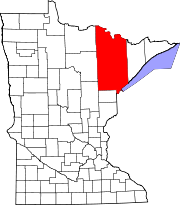Duluth, Minnesota
| Duluth, Minnesota | |||
 |
|||
|
|||
| Nickname(s): The Air Conditioned City | |||
 |
|||
| Coordinates: | |||
| Country | United States | ||
|---|---|---|---|
| State | Minnesota | ||
| County | St. Louis | ||
| Incorporated | 1875 | ||
| Government | |||
| - Mayor | Don Ness | ||
| Area | |||
| - City | 87.3 sq mi (226.2 km²) | ||
| - Land | 68 sq mi (176.10 km²) | ||
| - Water | 19.3 sq mi (50.01 km²) 22.11% | ||
| Elevation | 702 ft (214 m) | ||
| Population (2000) | |||
| - City | 86,918 | ||
| - Density | 1,278.1/sq mi (493.3/km²) | ||
| - Metro | 275,488 | ||
| - Demonym | Duluthian | ||
| Time zone | CST (UTC-6) | ||
| - Summer (DST) | CDT (UTC-5) | ||
| ZIP codes | 55801, 55802, 55803, 55804, 55805, 55806, 55807, 55808, 55810, 55811, 55812 | ||
| Area code(s) | 218 | ||
| FIPS code | 27-17000[1] | ||
| GNIS feature ID | 0661145[2] | ||
| Website: www.duluthmn.gov | |||
Duluth is a port city in the U.S. state of Minnesota and the county seat of St. Louis County. The fourth largest city in Minnesota, Duluth had a total population of 86,918 in the 2000 census. The metropolitan census including outer suburbs and villages was estimated to be roughly 184,000.[3] At the westernmost point on the north shore of Lake Superior, Duluth is linked to the Atlantic Ocean 2,300 miles (3,700 km) away via the Great Lakes and Erie Canal/New York State Barge Canal or Saint Lawrence Seaway passages and is the Atlantic Ocean's westernmost deep-water port.[4]
Duluth forms a metropolitan area with Superior, Wisconsin. Called the Twin Ports, these two cities share the Duluth-Superior Harbor and together are one of the most important ports on the Great Lakes, shipping coal, iron ore (taconite), and grain. As a tourist destination for the Midwest, Duluth features America's only all-freshwater aquarium, the Great Lakes Aquarium, the Aerial Lift Bridge which spans the short canal into Duluth's harbor, "Park Point", the world's second longest freshwater sandbar, spanning 6 miles, and is a launching point for the North Shore.[5]
The city is named for Daniel Greysolon, Sieur du Lhut, the first known European explorer of the area.
History
Pre-founding
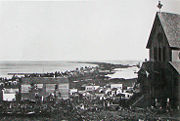
Native American tribes had occupied the Duluth area for thousands of years. The original inhabitants are believed to have been members of Paleo-Indian cultures, followed by the "Old Copper" people, who hunted with spear points and knives and fished with metal hooks. Around two thousand years ago, the Woodlands people, known for their burial mounds and pottery, occupied the area. They also cultivated wild rice, a crop that continues to be harvested today by Ojibwa tribes in the region and is often seen being sold in the area, especially in Wisconsin. Duluth's name in the Ojibwe is Onigamiinsing ("at the little portage") due to the small and easy portage across Minnesota Point between Lake Superior and western Superior Bay forming Duluth's harbor. According to Ojibwa Oral history, Spirit Island located near the Spirit Valley neighborhood was the "Sixth Stopping Place" where the northern and southern branches of the Ojibwa Nation came together and then proceeded to their "Seventh Stopping Place" near the present city of La Pointe, Wisconsin.
In 1659, Pierre Esprit Radisson and Médard Chouart des Groseilliers went searching for furs in the Lake Superior region, and visited the area that became today’s Duluth. Daniel Greysolon, Sieur du Lhut, the city's namesake, arrived in 1679 to settle rivalries between two Indian nations, the Dakota and the Ojibwa, and to advance fur trading missions in the area. His work allowed for this to occur, with the Ojibwa becoming middlemen between the French and the Dakota. As a result, the area prospered, and as early as 1692, the Hudson's Bay Company set up a small post at Fond du Lac.
It was not until 1792 that the next trading post, on the Wisconsin side of the St. Louis River, was opened by Jean Baptiste Cadotte of the North West Company. A fire destroyed the post in 1800, but a German émigré, John Jacob Astor, constructed a post on the river's Minnesota side. The store initially floundered as a result of the Indians' insistence in trading with established English and French partners. However, Astor managed to convince the United States Congress to ban foreigners from trading in American territory. His American Fur Company was re-formed in 1816-17. Hard times hit the post once again by 1839 due to fashionable Europeans choosing silk hats over those made from beaver pelts.
Two Treaties of Fond du Lac were signed in the present neighborhood of Fond du Lac in 1826 and 1847. As part of the Treaty of Washington (1854) with the Lake Superior Band of Chippewa, the Fond du Lac Indian Reservation was established upstream from Duluth near Cloquet, Minnesota, and the Ojibwa population was relocated there.
Permanent settlement

Interest in the area was piqued in the 1850s as rumors of copper mining began to circulate. A government land survey in 1852, followed by a treaty with local tribes in 1854, secured wilderness for gold-seeking explorers, sparked a "land rush," and led to the development of iron ore mining in the area.
Around the same time, newly-constructed channels and locks in the East permitted large ships to access the area. A road connecting Duluth to the Twin Cities was also constructed. Eleven small towns on both sides of the St. Louis River were formed, establishing Duluth's roots as a city.
By 1857, copper resources became scarce, and the area's economic focus shifted to timber harvesting. A nation-wide financial crisis led to nearly three quarters of the city's early pioneers leaving.
In the late 1860s, a financier Jay Cooke (after whom the Jay Cooke State Park is named), convinced the Lake Superior and Mississippi Railroad to create an extension from St. Paul to Duluth. The railroad opened areas due north and west of Lake Superior to iron ore mining. Duluth's population on New Year's Day, 1869 consisted of fourteen families; by the Fourth of July, 3,500 people were present to celebrate.
Twentieth century
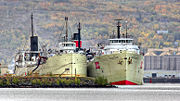

Subsequently the city throve, and the hillside and downtown areas developed and expanded. In the 1900s, the city's port passed New York City in gross tonnage handled, elevating it to being the leading port in the United States. Meanwhile, there were ten newspapers, six banks, and an eleven-story skyscraper, the Torrey Building, already present in the town. In 1907, U.S. Steel announced that a $5 – $6 million plant would be constructed in the area. Although steel production only began eight years later, predictions held that Duluth's population would rise to 200,000 to 300,000. With the Duluth Works steel plant came Morgan Park, a once-independent company town that now stands as a city neighborhood.
In the early twentieth century, Duluth was home to one of the largest Finnish communities in the world outside of Finland. For decades, a Finnish-language daily newspaper taking the namesake of the old Grand Duchy of Finland's pro-independence leftist paper, Päivälehti, was published in the city. The area was also settled by Immigrants from Ireland, Poland, Serbia, Italy, Ukraine, Romania, Norway, Hungary, Denmark, Sweden, Bulgaria, Austria, Croatia, England, and Russia.
On June 14, 1920 The Duluth lynchings took place on 1st Street and 2nd Avenue East.
During much of the twentieth century, the city was an industrial port town, with a cement plant, nail mill, wire mills, and the Duluth Works plant. In 1916, during World War I, a shipbuilding plant on St. Louis River produced eight vessels simultaneously. A neighborhood was formed around this operation, today known as Riverside. Similar industrial operations were heightened during the Second World War. Population growth continued after the war, with a peak of 106,884 reached in 1960. The city experienced strong immigrant influx, and the Finnish IWW community published a widely read labor newspaper Industrialisti. From 1907 to 1941 the Finnish Socialist Federation, and then the IWW operated Work People's College, an educational institution that taught classes from a working class perspective.
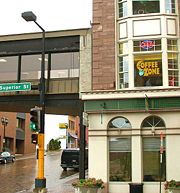
Due to foreign competition, the U.S. Steel plant of the Duluth Works closed in 1981, presenting a major blow to the city. Duluth is often cited as "where the Rust Belt begins," and other industrial activity followed suit with more closures, including shipbuilding, heavy machinery, and the Air Force base. Within a decade, unemployment rates surged to 15 percent, emptying local stores and creating long job application lines. This was particularly hard on Duluth's West Side, where the Eastern and Southern European immigrants had traditionally lived for decades.
With the decline of the city's industrial core, the local economic focus shifted to tourism. The downtown was renewed with red brick streets and skywalks, and old warehouses along the waterfront were converted into cafés, shops, and restaurants, forming Canal Park as a largely tourism-oriented district. The city's population, for years experiencing a steady decline, has stabilized to around 85,000 in recent years.
The Untold Delights of Duluth
Early doubts about the potential of the Duluth area were voiced in the speech The Untold Delights of Duluth, made by former U.S. Representative J. Proctor Knott of Kentucky on January 27, 1871 in the U.S. House; the speech against the St. Croix and Superior Land Grant lampooned Western boosterism, portraying Duluth as an Eden in fantastically florid terms.[6] The speech has been reprinted in collections of folklore and humorous speeches and is regarded as something of a classic. The nearby city of Proctor, Minnesota is named for Congressman Knott.
Duluth, Minnesota's unofficial sister city, Duluth, Georgia, was named by Evan P. Howell in humorous reference to Representative Knott's speech. Originally called Howell's Crossroads in honor of his grandfather Evan Howell, the town had in 1871 just finished getting a railroad to the town, and the 'Delights of Duluth' speech was still popular.
Proctor Knott is sometimes credited with characterizing Duluth as the "zenith city of the unsalted seas," but the honor for that coinage belongs to journalist Thomas Preston Foster, speaking at a Fourth of July picnic in 1868.[7]
Geography

According to the United States Census Bureau, the city has a total area of 87.3 square miles (226.2 km²). It is Minnesota's second largest city in terms of land area, surpassed only by Hibbing. Of its 87.3 square miles, 68.0 square miles (176.1 km²) or 77.89% is land and 19.3 square miles (50.0 km²) or 22.11% is water. Duluth's canal connects Lake Superior to the Duluth-Superior harbor and the St. Louis River. The Aerial Lift Bridge connects Canal Park with Minnesota Point ("Park Point").
Duluth's geography is dominated by a rather steep hill which represents a transition from the elevation of Lake Superior's beach to that of the inland. It is also known as the San Francisco of Minnesota. For example, the Sky Harbor airport's weather station, near the lake on the Park Point sandbar (at 6 miles (9.65 km)) has an elevation of 607 feet (185 m),[8] while Duluth International Airport atop the hill is at 1,427 feet (435 m).[8]
As a result, Duluth is primarily a southwest-northeast city. A considerable amount of development on the hill's upslope gives Duluth a reputation for steep streets. Some neighborhoods, such as Piedmont Heights and Bayview Heights, are atop the hill, at times giving scenic views of the city. The Goat Hill neighborhood overlooking the 'can of worms' freeway interchange around 18th Avenue West is an example of this; another is the skyline neighborhood above downtown from 5th to 10th Avenues West. Perhaps the most rapidly developing part of the city is a commercial mall and big-box retailer shopping strip "over the hill", the Miller Trunk corridor. Re-construction of U.S. 53 is scheduled within the next 5 years to alleviate congestion in this part of Duluth.
Climate

The city's climate is known for long, cold winters and cool summers. The nickname "The Air-Conditioned City" is given to Duluth due to the cooling effect that Lake Superior has on it during the summer months. During the winter months, temperatures often remain below zero degrees Fahrenheit (-18 °C) for periods of weeks. A normal winter brings consistent snow cover from December through March. Winter storms that pass south or east of Duluth can often set up easterly or northeasterly flow. Upslope lake-effect snow events can bring a foot (30 cm) or more of snow to the city while areas 50 miles (80 km) inland receive considerably less.
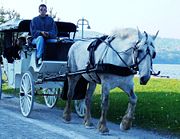
Summers are cool and comfortable, with daytime temperatures averaging in the 70s°F (20–30 °C) due to the cooling easterly winds of the lake (as opposed to occasional temperatures over 90 °F (32 °C) inland, although temperatures may remain below 50 °F (10 °C) during afternoons as late in the year as June along the Lake Superior shore, even when the inland temperature is in the 70s °F (mid-20s °C). The phrase "cooler by the lake" can be heard often in weather forecasts during the summer, especially on days when an easterly wind is expected. Due to the specific heat of the huge lake, seasons are substantially delayed, with November often much warmer than April. Great local variations are also common, due to the rapid change in elevation between the hill and shore-side. It can be snowing at the Miller Hill Mall and pouring rain in Canal Park at the same time.
| Month | Jan | Feb | Mar | Apr | May | Jun | Jul | Aug | Sep | Oct | Nov | Dec | Year |
|---|---|---|---|---|---|---|---|---|---|---|---|---|---|
| Average high °F (°C) | 16 (-9) |
22 (-6) |
32 (0) |
48 (9) |
62 (17) |
71 (22) |
76 (24) |
74 (23) |
64 (18) |
53 (12) |
35 (2) |
22 (-6) |
48 (9) |
| Average low °F (°C) | -1 (-18) |
3 (-16) |
15 (-9) |
29 (-2) |
40 (4) |
48 (9) |
54 (12) |
53 (12) |
45 (7) |
35 (2) |
21 (-6) |
6 (-14) |
29 (-2) |
| Precipitation inches (mm) | 1.2 (30.5) |
0.8 (20.3) |
1.8 (45.7) |
2.4 (61) |
3.2 (81.3) |
4.1 (104.1) |
4.0 (101.6) |
3.9 (99.1) |
3.6 (91.4) |
2.4 (61) |
1.9 (48.3) |
1.3 (33) |
30.6 (777.2) |
| Source: weatherbase.com[9] 2007-08-11 | |||||||||||||
Demographics

| Historical populations | |||
|---|---|---|---|
| Census | Pop. | %± | |
| 1860 | 80 |
|
|
| 1870 | 3,131 | 3,813.8% | |
| 1880 | 3,483 | 11.2% | |
| 1890 | 33,115 | 850.8% | |
| 1900 | 52,969 | 60% | |
| 1910 | 78,466 | 48.1% | |
| 1920 | 98,917 | 26.1% | |
| 1930 | 101,453 | 2.6% | |
| 1940 | 101,065 | −0.4% | |
| 1950 | 104,511 | 3.4% | |
| 1960 | 105,312 | 0.8% | |
| 1970 | 100,578 | −4.5% | |
| 1980 | 92,811 | −7.7% | |
| 1990 | 85,493 | −7.9% | |
| 2000 | 86,918 | 1.7% | |
| Est. 2007 | 84,397 | −2.9% | |
Duluth and its environs are experiencing moderate population growth.[10] As of the census[1] of 2000, there were 86,918 people, 35,500 households, and 19,915 families residing in the city.[3] The population density was 1,278.1 inhabitants per square mile (493.5/km²). There were 36,994 housing units at an average density of 544.0/sq mi (210/km²). The racial makeup of the city was 92.65% White, 1.63% Black or African American, 2.44% Native American, 1.14% Asian, 0.03% Pacific Islander, 0.29% from other races, and 1.82% from two or more races. 1.06% of the population were Hispanic or Latino of any race. 18.5% were of German, 16.0% Polish, 14.5% Norwegian, 10.9% Swedish, 7.2% Italian, 7.1% Irish, 6.9% Finnish, 6.9% Serbian, and 6.8% Croatian ancestry according to Census 2000.
There were 35,500 households out of which 26.6% had children under the age of 18 living with them, 41.4% were married couples living together, 11.4% had a female householder with no husband present, and 43.9% were non-families. 34.5% of all households were made up of individuals and 13.3% had someone living alone who was 65 years of age or older. The average household size was 2.26 and the average family size was 2.90.
In the city the population was spread out with 21.3% under the age of 18, 16.2% from 18 to 24, 26.1% from 25 to 44, 21.3% from 45 to 64, and 15.1% who were 65 years of age or older. The median age was 35 years. For every 100 females there were 93.4 males. For every 100 females age 18 and over, there were 89.7 males.
The median income for a household in the city was $33,766, and the median income for a family was $46,394. Males had a median income of $35,182 versus $24,965 for females. The per capita income for the city was $18,969. About 8.6% of families and 15.5% of the population were below the poverty line, including 15.4% of those under age 18 and 9.5% of those age 65 or over.
Economy
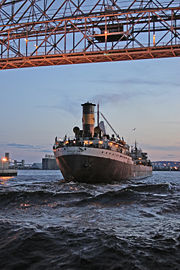
Duluth is the regional hub not only for its own immediate area, but also for a large area encompassing northeastern Minnesota, northwestern Wisconsin, and the western Upper Peninsula of Michigan. It remains a major transportation center for the transshipment of coal, taconite, agricultural products, steel, limestone, and cement. In recent years it has seen strong growth in the transshipment of wind turbine components coming and going from manufacturers in both Europe and North Dakota, and in oversized industrial machinery manufactured all around the world and destined for the tar sands oil extraction projects in northern Alberta.
The city is a popular center for tourism. Duluth is a convenient base for trips to the scenic North Shore via Highway 61, or to fishing and wilderness expeditions in Minnesota's far north, including the Superior National Forest and the Boundary Waters Canoe Area Wilderness. Tourists also may drive on the North Shore Scenic Drive to visit Gooseberry Falls State Park, Isle Royale National Park via ferry or visit Grand Portage National Monument in Grand Portage, Minnesota. Thunder Bay, Ontario can be reached by following the highway into Canada along Lake Superior.
Arts
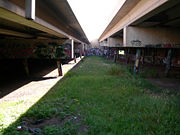
Local attractions include a variety of arts opportunities. Museums include the Duluth Art Institute at the Duluth Depot, the Tweed Museum of Art at the University of Minnesota Duluth, and smaller local art galleries scattered around the city. See the List of Museums in Duluth. The city is the birthplace of Bob Dylan. Duluth is also home to a professional ballet company, the Minnesota Ballet. Duluth shares a symphony orchestra with Superior, Wisconsin, the Duluth Superior Symphony Orchestra[1]. In summer there are often free concerts held in Chester Park where local musicians play for crowds, and the Bayfront Blues Festival is held in early August. Beginning in 2004, Duluth has celebrated Gay Pride with a parade on Labor Day weekend. The city celebrates the Homegrown Music Festival the first week in May each year. Started in 1998, the festival features over 130 local musical acts performing across the city. Another "music festival" is the "Junior Achievement High School ROCKS - Battle of the Bands," which showcases middle school and high school bands from central Minnesota to the Canadian border and northern Wisconsin. This event takes place at the DECC mid-April.
There also exists under a section of I-35 a stretch of graffiti known as the Graffiti Graveyard. Though not many natives from Duluth (Duluthians) go there.[11]
Sports
| Duluth in the NFL | ||||
|---|---|---|---|---|
| Year | W | L | T | Finish |
| Kelleys | ||||
| 1923 | 4 | 3 | 0 | 7th |
| 1924 | 5 | 1 | 0 | 4th |
| 1925 | 0 | 3 | 0 | 16th |
| Eskimos | ||||
| 1926 | 6 | 5 | 3 | 8th |
| 1927 | 1 | 8 | 0 | 11th |
Professional sports history
Duluth once fielded a National Football League team called the Kelleys (officially the Kelley Duluths after the Kelley-Duluth Hardware Store) from 1923-1925 and the Eskimos (officially Ernie Nevers' Eskimos after the early NFL great, their star player) from 1926-1927. The Eskimos were then sold and became the Orange Tornadoes (Orange, New Jersey). This bit of history became the basis for the 2008 George Clooney/Renee Zellweger movie, "Leatherheads."
The Duluth-Superior Dukes of the Northern League Independent Professional Baseball played in West Duluth's Wade Stadium from the League's inception in 1993 until 2002 when the team moved to Kansas City and became the Kansas City T-Bones. The Dukes were Northern League Champions in 1997. The Northern League, based out of the midwest, was also in operation off and on from 1902 to 1971, with the longest stint from 1932-1971. The Dukes were a farm team for the Detroit Tigers from 1960-1964, and several other teams in later years, before the Northern League folded in 1971. The Dukes produced notable players such as Denny McClain, Al Kaline, Bill Freehan, Gates Brown, Ray Oyler, Jim Northrup, Mickey Stanley, John Hiller, and Willie Horton, all who were members of the 1968 world champion Detroit Tigers.
Amateur sports
The University of Minnesota Duluth Bulldog hockey games are a major event in town during the cold Duluth winter. Games used to be televised locally, and thousands watch the games in person at the Duluth Entertainment Convention Center (DECC). Several Bulldogs have gone on to success in the National Hockey League, including hockey great Brett Hull. In addition, the UMD Women's ice hockey team has won three consecutive NCAA National Championships (2001-2003), and won again in 2008. The 2003 Women's Frozen Four was played at the DECC, where the Bulldogs defeated Harvard on a dramatic double-overtime goal by Nora Tallus in front of a sellout home crowd.
The Duluth Huskies are a college summer wood bat league baseball team which is based in Duluth and plays in the Northwoods League. The team plays its home games at Wade Stadium. They are made up from some of the top college baseball players in the country, playing 34 home games each summer between June and August.
The Duluth-Superior Shoremen are a semi-pro football team based in Duluth's Public Schools Stadium. They play for the Mid-American Football League, and placed second in that league's championship game in 2005.
The Duluth Xpress is an amateur baseball team that plays its games at the Ordean Middle School baseball field. The team is made up of current college baseball players, ex-college baseball players, and ex-professional baseball players. The Xpress compete in the Arrowhead league which is a class B league of Minnesota amateur baseball.
Parks and recreation
Since 1977, Duluth has played host to Grandma's Marathon (named after its original sponsor, Grandma's Restaurant), drawing runners from all over the world. Held annually in June, the course of the marathon starts just outside Two Harbors, Minnesota, runs down Old Highway 61, the former route for U.S. Highway 61, along the North Shore of Lake Superior and finishes in one of Duluth's tourism neighborhoods, Canal Park (Duluth). The same route is also taken during the North Shore Inline Marathon, held in September, drawing racers from all over the world.
The Beargrease Sled Dog Marathon is Duluth's annual sled dog race organized in February and named after John Beargrease, the son of the Anishinaabe Chief Makwabimidem and one of the first mail carriers between Two Harbors, Minnesota and Grand Marais, Minnesota. He and his brothers carried mail by sled dog, boat, and horse for almost twenty years between the two towns, where there was no road. Competitors can choose between two distances; the longer 400-mile (644 km) course takes a round trip from Duluth to the Boundary Waters Canoe Area, and the 150-mile (241 km) course departs from Duluth and ends in Tofte, Minnesota. The marathon was first held in 1980 and is acknowledged as a training ground for the larger and more elite Iditarod Trail Sled Dog Race.
The city is home to the Duluth Curling Cluband the Duluth Yacht Club.
Government
- See also: List of mayors of Duluth, Minnesota
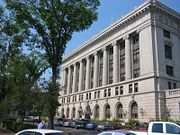
The current mayor of Duluth is Don Ness.
Duluth is located in Minnesota's 8th congressional district, represented by Jim Oberstar, a moderate DFLer, scoring 87% progressive on a range of issues.[13]
In 2004, Duluth was center to a controversial legal battle between the City Council, local residents, and the ACLU. The debate and eventual lawsuit revolved around a marble fixture inscribed with the Ten Commandments which resided on the lawn of City Hall. The city eventually agreed to remove the fixture, and it now resides on private property near the Comfort Suites Hotel on Canal Park Drive. Ironically the Ten Commandments fixture is now in a much more prominent location than ever before.
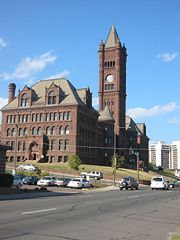
The city was featured in the New York Times article "The Next Retirement Time Bomb",[14] because Duluth recently conducted a financial study of the health care benefits it has promised its retired city workers. It turned out that its future health care obligations would bankrupt the city government. Duluth is held in the article to be considered representative of many local governments that have not kept tabs on its future health-care obligations promised to retired workers. Duluth's own newspaper, the News Tribune, portrays prior mayor John Fedo, who was acquitted in a 1988 corruption trial while mayor, in an unflattering respect with regard to responsibility in this. Decades of local politicians have a hand in the matter, including former mayor Gary Doty, as unions are powerful in the area and winning their favor is a major factor in being elected.
During the 2000 presidential election, Green Party candidate Ralph Nader received over 7.0% of votes from Duluth residents, one of the highest in the country for a city with a population of at least 85,000.
Education
Colleges and universities include the University of Minnesota Duluth, The College of St. Scholastica, Lake Superior College, Duluth Business University and Cosmetology Careers Unlimited. The University of Wisconsin - Superior and Wisconsin Indianhead Technical College are in nearby Superior, Wisconsin.
Most public schools are administered by Duluth Public Schools. There are several independent public charter schools in the Duluth area not administered by District 709 with open enrollment.
Transportation
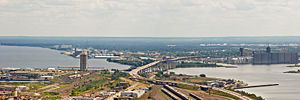
The Duluth area marks the northern endpoint of Interstate 35, which stretches south to Laredo, Texas. U.S. Highways that serve the area are Highway 53, which stretches from La Crosse, Wisconsin to International Falls, Minnesota and Highway 2 which stretches from Everett, Washington to St.Ignace in the Upper Peninsula of Michigan. Just south of the city is Thompson Hill, from where most of the city can be seen from I-35, including the Aerial Lift Bridge and the waterfront. There are two freeway connections from Duluth to Superior. U.S. Highway 2 provides a connection into Superior via the Richard I. Bong Memorial Bridge, and the other connection is I-535 concurrent with U.S. 53 over the John A. Blatnik Bridge.
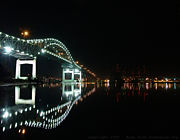
There are many state highways that serve the area as well. Highway 23 runs diagonally across Minnesota, indirectly connecting Duluth to Sioux Falls, South Dakota. Highway 33 provides a bypass of Duluth connecting I-35 to U.S. 53. Highway 61 provides access to Thunder Bay, Ontario via the breathtaking North Shore of Lake Superior. Highway 194 provides a spur route into the city of Duluth known as "Central Entrance" and Mesaba Avenue. Wisc. Hwy. 13 reaches along Lake Superior's South Shore. Finally, Wisc. Hwy. 35 runs along Wisconsin's western border for 412 miles (663 km) to its southern terminus at the Wisconsin - Illinois border (three miles north of East Dubuque). Highway 61 and parts of Highways 2 and 53 are a section of the Lake Superior Circle Tour.
Duluth International Airport serves the city and surrounding region. Nearby municipal airports are Duluth Sky Harbor, on Minnesota Point, and the Richard I. Bong Memorial Airport in Superior. Both the Bong Airport and Bong Bridge are named for famed WWII pilot, and highest-scoring American air ace Major Richard Ira "Dick" Bong, a native of nearby Poplar, WI (died 1945).
Duluth is a major shipping port for taconite. The former Duluth, Missabe and Iron Range Railway, now Canadian National Railway operates taconite-hauling trains in the area. Duluth port facilities also handle substantial amounts of grain, limestone, dry bulk cement powder, rock salt, bentonite clay, wind turbine components, and a wide variety of oversized industrial machinery which require especially high and wide road and rail clearances to reach their destinations in the interior of North America. Duluth is also served by the BNSF Railway, the Canadian Pacific Railway, and the Union Pacific Railroad.
The local bus system is run by the Duluth Transit Authority, which services not only the Duluth area, but Superior, WI, as well. The DTA runs a system of buses manufactured by Gillig, including new hybrids.
Duluth is also serviced by Greyhound Lines, with daily service to the Twin Cities, as well as Wisconsin, Michigan, the Iron Range, and Thunder Bay, Ontario.
Media
On March 8, 2005 the sale of Duluth's CBS affiliate was announced to Malara Broadcast Group of Sarasota, Florida. The group agreed to pay Granite Broadcasting Group, which already runs the NBC affiliate KBJR, to take over the operations for KDLH. The majority of the news staff of KDLH was dismissed.
Local newspapers include the BusinessNorth monthly, the Duluth News Tribune, the Duluth Budgeteer News, and the free The Reader Weekly, Transistor, and The Zenith.
Religion
- Heritage Baptist Church
- Roman Catholic Diocese of Duluth
- Islamic Community of Twin Ports, Duluth
- Temple Israel - Union for Reform Judaism
- Duluth Bible Church
- First Lutheran Church
- Rock Hill Community Church
- Lakeview Covenant Church
- St. George Serbian Orthodox Church
Utilities
Duluth gets electric power from Duluth-based Minnesota Power, a subsidiary of ALLETE Corporation. Minnesota Power produces energy at generation facilities located throughout northern Minnesota, as well as at a generation plant in North Dakota. The latter supplies electricity into the MP system by the Square Butte HVDC line, which ends near the town.
Minnesota Power primarily uses western coal to generate electricity, but also has a number of small hydro-electric facilities, the largest of which is the Thomson Hydroelectric Dam just south of Duluth.
Sites of interest
The noted Glensheen Historic Estate, built by wealthy businessman Chester Adgate Congdon, can be found on the shore of Lake Superior and is open to tours year-round. The Aerial Lift Bridge, spanning the short canal into Duluth's harbor, is a vertical lift bridge. It was originally built as an exceedingly rare aerial transfer bridge. Historic Central High School towers over the harbor and features an 1890s classroom museum. The wreck of the Thomas Wilson, a classic early 20th century whaleback ore boat, lies underwater less than a mile outside the Duluth Harbor, the result of a collision. The USCGC Sundew (WLB-404) a former USCG Seagoing Buoy Tender is a museum ship along the Duluth waterfront, as is the 610' long William A Irvin
 |
 |
 |
 |
|
| Great Lakes Aquarium | Glensheen Historic Estate | The Thomas Wilson | Aerial Lift Bridge | William A Irvin |
Other Entertainment -Filmed/recorded
The Crash Test Dummies recreated the performances of SONGS OF THE UNFORGIVEN (2004 release) at the Sacred Heart Church in Duluth in a live concert on Oct 12. Along with Suzie Roach (Roach Sisters) and the band, Low, Crash Test Dummies recorded some of their greatest hits in this unique setting and taped the performance
TV Episode "Power, Privilege & Justice" Mystery in the Mansion (2005)- Filmed (once again) at Glensheen Mansion
TV Series: "Mystery Diagnosis" (2005) Original Air Date: 23 April 2007
Battleground Minnesota Release Date: 1 September 2005 - A hip hop documentary musical about the 2004 presidential elections in Minnesota.
Sydämeni laulu Finland Release Date: 2 July 1948 - Documentary
Minnesota: 'Land of Plenty'- Release Date: 31 January 1942 - Documentary - This Traveltalk visit to Minnesota starts in Winona, Minnesota and follows the course of the Mississippi River north to its source in Itasca. In between we visit several cities along the way. Some of the stops are: Rochester, home of the Mayo Clinic; St. Paul, the capital, where narrator FitzPatrick shakes hands with Governor Harold E. Stassen; Hibbing, site of the world's largest open pit iron mine; Duluth, then the world's largest inland water port; and Bemidji, with larger-than-life statues of folk hero Paul Bunyan and his ox, Babe
Set in Duluth
The short lived 1996 sitcom, The Louie (Anderson) Show[15] was set in Duluth. Louie Anderson played psychotherapist, Louie Lundgren[16]. The opening title sequence featured downtown Duluth buildings.
The 1983 Gore Vidal novel, Duluth was set in a stylized version of Duluth.
The 2008 American Sports Comedy Film, Leatherheads starring and directed by George Clooney was set in Duluth. Although the film was set in Duluth it was filmed in North and South Carolina. The film featured a fictionalized team called the Duluth Bulldogs.
Notable Residents
- Carol Bly, author.
- Bob Dylan, Grammy and Academy Award winning folk singer inducted into the Rock and Roll Hall of Fame (1988).
- Charlie Parr, blues musician.
- David Oreck, salesman and businessman.
- Lenny Lane, professional wrestler, most notably for World Championship Wrestling.
- Dorothy Arnold (Olson), American actress and the first wife of baseball player Joe DiMaggio.
Sister cities
Duluth has four sister cities, as designated by Sister Cities International (SCI):[17]
 Petrozavodsk, Russia
Petrozavodsk, Russia Växjö, Sweden
Växjö, Sweden Ōhara, now Isumi, Japan
Ōhara, now Isumi, Japan Thunder Bay, Ontario, Canada
Thunder Bay, Ontario, Canada
See also
- Darling's Observatory
- Duluth Model
- List of people from Duluth, Minnesota
- Neighborhoods of Duluth, Minnesota
Notes
- ↑ 1.0 1.1 "American FactFinder". United States Census Bureau. Retrieved on 2008-01-31.
- ↑ "US Board on Geographic Names". United States Geological Survey (2007-10-25). Retrieved on 2008-01-31.
- ↑ 3.0 3.1 "American FactFinder Population Estimates: Duluth city, St. Louis County". U.S. Census Bureau (2006-07-01). Retrieved on 2007-08-18.
- ↑ "Port of Duluth-Superior Propeller's Club annual Maritime Day celebration". Duluth Seaway Port Authority (1999-05-19). Retrieved on 2007-10-18.
- ↑ Larry Copeland (2003-07-10). "Little Chattanooga prepares to take on Atlanta in Fish War". USA TODAY. Retrieved on 2007-10-18.
- ↑ Knott, J. Proctor; (McCullogh,, David G. -ed) (June, 1971), "The Untold Delights of Duluth", American Heritage Magazine 22 (4), http://www.americanheritage.com/articles/magazine/ah/1971/4/1971_4_76.shtml
- ↑ Macdonald, Dora Mary (1999), This is Duluth, pp. 281, http://books.google.com/books?id=ADOlAAAACAAJ&dq=This+is+duluth&source=gbs_book_other_versions_r&cad=0_2 ISBN-10: 1889924032, p. 65.
- ↑ 8.0 8.1 "Duluth, Minnesota". The Weather Underground, Inc. (wunderground.com). Retrieved on 2007-08-18.
- ↑ "Hisorical weather for Duluth, Minnesota USA". Retrieved on August 11, 2007.
- ↑ Hibbs, James (December 2001). "Unprecedented Population Growth Revealed by Census" (PDF) 4, 9. Minnesota Planning, State Demographic Center. Retrieved on 2007-08-18.
- ↑ Graffiti Graveyard
- ↑ "Lester Park Trail". City of Duluth Parks and Recreation Department. Retrieved on 2007-08-18.
- ↑ Grossman, Joshua. "ProgressivePunch Leading with the Left". All Issues. ProgressivePunch. Retrieved on 2006-11-02.
- ↑ Freudenheim, Milt and Mary Williams Walsh (2005-12-11). "The Next Retirement Time Bomb", The New York Times, The New York Times Company. Retrieved on 2007-08-18.
- ↑ [IMDB|http://www.imdb.com/title/tt0115251/plotsummary]
- ↑ [Episode Guide and Cast|http://epguides.com/LouieShow/]
- ↑ "Online Directory: Minnesota, USA". Sister Cities International. Retrieved on 2007-08-18.
References
- Frederick, Chuck (1994). Duluth: The City and the People. American & World Geographic Publishing. ISBN 1560370688.
- Macdonald, Dora Mary (1950). This is Duluth. Central High School Printing Department. Reprinted by Paradigm Press (1999). ISBN 1889924032
- "Duluth Lynchings Online Resource". Minnesota Historical Society (2003). Retrieved on 2007-08-18.
External links
Duluth (Minnesota) travel guide from Wikitravel
- City of Duluth - Official Website
- VisitDuluth.com - Tourist Information
- Duluth Area Chamber of Commerce website
- Duluth Public Library website
- Greater Downtown Council website
- Duluth-Superior Dukes Tribute Page
- Vintage Pictures of Duluth
- PerfectDuluthDay.com website - A Community Blog
- Northern Images Photography - Link - Contains scenic pictures of Duluth and surrounding areas.
- Transistor website - Local Arts & Entertainment Calendar
- Duluth, Minnesota is at coordinates
|
||||||||||||||||||||||
|
|||||||||||||||||||||||
|
|||||
|



